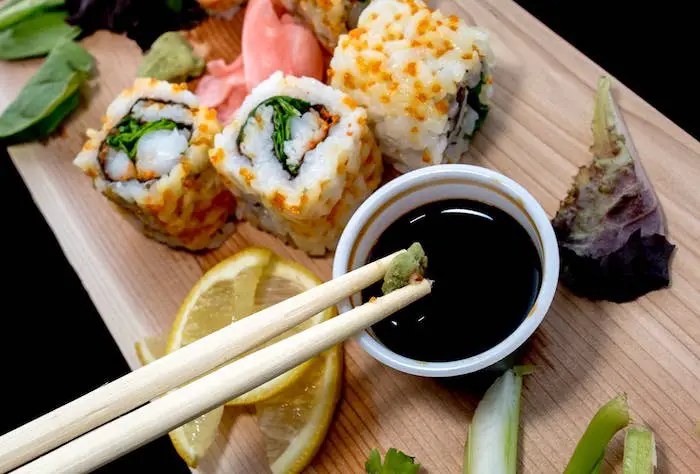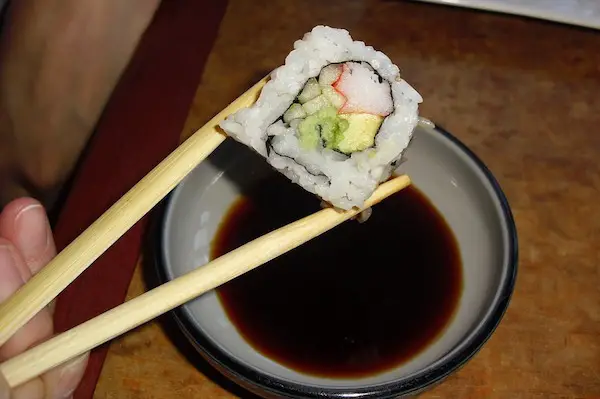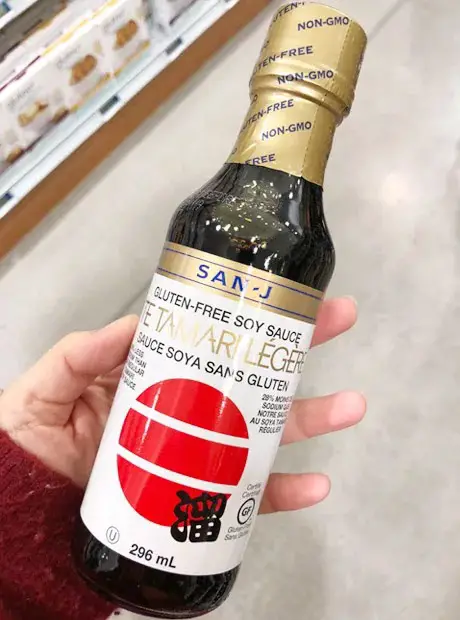We are reader supported. When you purchase through links on our site, we may earn an affiliate commission. Also, as an Amazon affiliate, we earn from qualifying purchases.

If you are a fan of sushi like me, you have probably heard of shoyu (soy sauce) and tamari. While the Americans may use them interchangeably, shoyu and tamari have their distinct place in Japanese cuisine. Both these sauces differ widely in terms of preparation, taste, and flavour.
I have often seen people get confused when they see tamari, because they have no idea how it is different from the familiar shoyu. In this article, I will help you gain a better understanding of both, and also take a look at the differences that make them unique.

Shoyu is the Japanese name for soya bean sauce, a dark brown condiment made from soybeans that undergoes a centuries-old fermentation process. Soy sauce is widely used in Japanese cuisine and serves as a dipping for sushi and sashimi. It typically contains a mix of soybeans, wheat, water, and salt.
Tamari like this is derived from the Japanese word ‘tamaru’ which means to gather or accumulate. Originally, it was the liquid by-product collected after the miso-making process that involved fermenting the soybeans. The liquid contains only soybeans and no wheat.
Today, Tamari is popularly known as the gluten-free soy sauce which has a thicker texture, stronger flavour, and deeper color. However, the popularity of Tamari is not just due to the absence of wheat. It also contains less amount of additives and is higher in protein content.
How Are Shoyu And Tamari Prepared
Shoyu is often referred to as soya sauce and has its origins in China. The original Chinese soy sauce is over 2500 years old. The traditional production process involves soaking soybeans and mixing it with roasted and crushed wheat. Water, salt, and a culturing mold is added to the mix and it is then allowed to ferment for 18 months or more.
Artificial coloring agents and chemicals may be used at times to enhance the flavor and taste. As shoyu is the end-product of a biochemical process, the compositions may vary widely. The traditional organic soy sauce tends to have a stronger flavor than the commercially made ones. You may also find reduced-sodium soy sauce that is fermented for 3 years or more to get that characteristic taste.
Thus, the soy sauce may vary in taste and flavor depending upon the fermentation years, the difference in ingredients, and so on. It may be divided into five main types based on the method of production and ingredients used – koikuchi (dark soy sauce), tamari (gluten-free sauce), shiro (fewer soybeans and more wheat content), usukuchi (light sauce), and saishikomi (uses enzyme instead of water).
Tamari is a type of shoyu that originated in the Chubu region of Japan. Many traditionalists claim that this is the original Chinese soy sauce as the recipe is close to what was initially introduced to Japan. Technically this sauce is achieved as a by product of miso paste. It is the accumulated liquid that sweats off miso as it matures.
Tamari sauce is solely made from fermented soybeans without adding any wheat or other ingredients to it. Due to the high concentration of soybeans, without any additives, the sauce tends to have a smoother, yet bolder and richer flavor. Tamari is mostly used as a dipping sauce than a cooking agent.
Difference Between Shoyu And Tamari

Ingredients
The biggest difference between shoyu and tamari is the presence of wheat, which you typically find in the former. The commercially produced soy sauce may feature caramel color, corn syrup, and hydrochloric acid, so always stick to the naturally fermented products.
Gluten Content
As shoyu contains wheat, the sauce is laden with gluten which is not suitable for people with celiac disease or those who are gluten sensitive. Tamari on the other hand is free of wheat, thus it serves as a great alternative for people on a gluten-free diet.
Additives
If you carefully take a look at any regular bottle of shoyu available at the grocery store, you can see a long list of ingredients. I can bet that there will be some names that you have never heard before and may sound more suitable for a science lab.
The tamari sauce on the other hand usually does not contain so many preservatives, food additives, or extra ingredients that can potentially damage your health. Pick any tamari bottle and you are likely to find only three basic ingredients – soybeans, water, and salt.
Versatility
You can easily use tamari as a substitute for soy sauce in almost any sushi recipe without altering the flavor or aroma. Unlike shoyu, tamari boasts a full-bodied flavor which is not lost even when you cook in high heat.
Shoyu on the other hand cannot be used as a substitute for tamari because soy sauce contains gluten and additives which are not suitable for people on celiac diet.
Protein level
If you are concerned about the health benefits you get from eating sushi with soy sauce then you will find this information interesting. According to studies, tamari contains double the protein level you can find in regular soy sauce.
So, if you are looking for a healthier sauce option that can keep your bones healthy and control your weight, consider substituting shoyu with tamari.
Texture and flavor
Tamari is known to have a thicker texture and richer flavour due to the higher concentration of soybeans that is not diluted by adding any preservatives. As a result, you get a stronger and full-bodied flavour.
Soy sauce, on the other hand, has a thinner consistency and weaker taste when compared to tamari. As a result, a little bit of tamari is enough in recipes and it helps in keeping the sodium intake under control.
Taste
Shoyu is saltier than tamari due to the brine solution used in the fermentation process. Some brands may have a pungent taste due to the number of years in fermentation process. Tamari has a more bold taste and less salty flavour.
Uses
Traditionally, shoyu or soy sauce has been used in the preparation of Japanese dishes like fried rice, sushi or sashimi. Tamari sauce is used as a salad dressing or dipping to lend an umami flavour.
Tamari has shot to popularity in recent years primarily for its gluten-free characteristic. People who wish to eat healthily and avoid gluten in their food preferences to use tamari instead of shoyu.
| Shoyu | Tamari | |
| Country of origin | Japan | China |
| Made from | By product of soybeans | Byproduct of miso paste |
| Ingredients | Soybeans, wheat, water, and salt | Soybeans, water, and salt |
| Production method | Fermentation or by hydrolysis method | Liquid extracted from miso paste |
| Gluten content | Made from wheat so contains gluten | Mostly gluten-free |
| Sodium content | Salty | Less salty |
| Flavor | Flavor varies from brand to brand | Full bodied flavor |
| Resistance to heat | Loses flavor when exposed to high heat | Does not lose flavor when cooked in high temperature |
| Taste | Has a strong and sharp taste | Has a smoother and lighter taste |
| Texture | Thinner in consistency | Has a richer and thicker texture |
Tips To Buy The Right Soy Sauce
#1. Most food recipes will not include which types of soy sauce to use and it will depend upon your personal discretion and preference. Many people who prefer gluten-free food opt for tamari while others may like to stick to the authentic flavor of soy sauce.
#2. You will find light and dark soy sauce, depending on the period of aging. The more it ages, the darker it becomes. The Chinese soy sauce is thinner and lighter, but more intense in flavor.
#3. An unopened bottle of soy sauce can last for long, but once it’s opened, it should be consumed in a year or two. As exposure to oxygen can spoil the flavor, I would suggest that you choose a smaller bottle over a large tin, unless you use it excessively in cooking.
#4. Read the labels on the sauce bottle to watch for any artificial preservatives that may be present. If you find ingredients like potassium sorbate and sodium benzoate, this should raise a red flag. Naturally fermented soy sauce does not require artificial caramel color.
#5. Is the sauce fermented in the natural method or chemically processed? The traditional soy sauces are made by fermenting soybeans and minimal ingredients for several months, while the chemically processed ones are made in a few days.
#6. In the past, there were only a few authentic brands but now you can find a plethora of new brands, some of which may not follow the standards. Make sure you read the label carefully to find the mention of certification logos for organic, Non-GMO, kosher, gluten-free, and vegan.
#7. Many people prefer a sauce with less sodium content and fortunately, you can find many brands that offer specially formulated reduced sodium soy sauces. However, many brands may compromise the taste in order to keep the sodium content low. Pick a brand that retains the authentic flavor while minimizing the sodium content.
#8. Tamari is usually prepared with only soybeans and no wheat, but some brands may contain a small amount of wheat. So, don’t just buy any brand selling tamari but check the label to make sure it is actually gluten-free.
Top 3 Brands For Shoyu And Tamari
Hama Shoyu: This is a traditional tamari sauce that carries a rich heritage of 120 years. It is typically fermented for two years and tastes best with both sushi and sashimi. The sauce is used in some of the most famous sushi restaurants in Japan.
Yamasa Less Salt Soy Sauce: If you are looking for a sauce that can keep your sodium intake low, this product is worth buying. This premium quality sauce has no added artificial flavors.
Japanese Yamaroku Sauce: This soy sauce blend contains bonito and kelp stock. It is aged and fermented for 2 years using ancient methods. No preservatives are used in the making of this sauce.
Related Questions
What is organic soy sauce?
It is created by naturally fermenting organic soybeans with wheat, water, and salt. The sauce is aged for months to give it a fresh, clean, and balanced taste.
How to store soy sauce correctly?
An opened bottle of soy sauce should be stored in a cool and dry place. While you don’t need to refrigerate soy sauce, doing so will increase the freshness window.
What does good soy sauce taste like?
Naturally fermented soy sauce that has been aged for several months will have a balanced taste with umami sweetness. The commercially produced ones have a bitter taste.
Related Article: Nitsume Vs Shoyu


